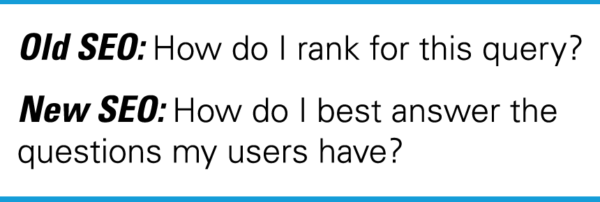Google Hummingbird & The Keyword: What You Need To Know To Stay Ahead
On September 26, Google told participants at its 15th anniversary event it had a new algorithm impacting more than 90 percent of searches worldwide. They called it “Hummingbird.” Google’s Amit Singhal later said it was perhaps the largest change to the algorithm since he joined the company back in 2001. This information made some marketers […]
On September 26, Google told participants at its 15th anniversary event it had a new algorithm impacting more than 90 percent of searches worldwide. They called it “Hummingbird.” Google’s Amit Singhal later said it was perhaps the largest change to the algorithm since he joined the company back in 2001.
This information made some marketers nervous, but at PubCon last week, Google’s Matt Cutts reminded the audience that the algorithm had been up and running for more than a month before it was announced, and no one even noticed.
Hummingbird allows the Google search engine to better do its job through an improvement in semantic search. As conversational search becomes the norm, Hummingbird lends understanding to the intent and contextual meaning of terms used in a query.
It seems that with Hummingbird, Google can now better answer those longer-tail queries even if a page is not optimized for them. So some pages may have a better chance of being found for certain queries now.
We saw clues this was coming. In fact, back in May, Google announced conversational search across devices plus improvements to the Knowledge Graph.
In the announcement, Singhal painted a picture of the future of search. “People communicate with each other by conversation, not by typing keywords — and we’ve been hard at work to make Google understand and answer your questions more like people do.”
Keywords Still Central To SEO
More recently, the loss of keyword data that skyrocketed from Google’s move toward 100 percent secure search punctuated the fact that at the same time, Google was getting better at search, and it was asking SEOs to move away from a strictly keyword-based approach.
So the question is: should SEOs be worrying about their strategy? And the answer is no — at least, not if they’ve been staying on the leading edge of SEO.
Why Google Hummingbird Means Business As Usual For Many SEOs
Google’s algorithm continues to be a complex mix of factors that weigh the relevancy of a page for a query. That hasn’t changed.
While some people may be panicking that their SEO strategy needs to be revamped, if you’ve been progressing with the natural evolution of SEO, there’s nothing to worry about. You’re on the right track.
Taking what we know about how Google is trying to improve its search results, here is just a sample of some of the things that continue to matter:
- Mobile SEO: Undoubtedly, conversational search is driven in part by the way people search when on their mobile devices — so, mobile optimization is going to continue to be critical.
- Structured Data Markup: Providing search engines with as much information as possible about your page content helps them do their job better. Structured data can also improve click-through rates in the search results when displayed in rich snippets.
- Google+: Google’s social network is essential in helping to identify your online brand, connecting it with concepts and serving your content in the Google results.
- Links: Google may not want SEOs obsessing over PageRank data, but that doesn’t mean links are irrelevant. Links help Google put concepts together on the Web; they also send strong signals to Google about the credibility of your page.
- Keyword Optimization & Content Creation: Nowadays, it seems there is a lot of debate over the usefulness of focusing on keywords. But keywords are not dead. Quality content is crucial, and that includes at least some level of keyword optimization.
Start With The User, Execute With Content, Measure By Page
SEO now requires a keener understanding of your audience. It doesn’t start or end with keywords; rather, it starts with the user and an understanding of what your user wants.
Users: What Matters To Them & How Can You Help?
Your content may have four or five different types of users, who are searching for the answer to a query. Understanding what’s being served to which user and catering to those important segments with a good user experience on your site is key.
Currently, personas are talked about more than ever in the search marketing world. Traditional marketers have long since used this model to better understand their product or service user. This depth of understanding is important as you think about the topics your users are interested in and how you can be a solution for them with your content.
Keyword research still guides us to the topics people in our audience are searching for; but, our responsibility as marketers is to go beyond that data. That means having the most useful, most engaging, best quality page for a query – with the appropriate keywords on the page.
And although keyword optimization often happens best when a topic is thoughtfully written, and has enough depth to include many variations of a concept, optimizing your page for specific queries still reinforces the topic of the page.
If you haven’t spent much effort gathering qualitative data about your users, now is a good time to start. Surveys, monitoring conversations on social and talking face-to-face with your customers will help you build those personas to better understand what matters to them, so you can execute with content. But more on that in another post.
The Page: How Is It Performing?
At BrightEdge, we’ve been arming our customers with ways to measure our content’s performance at a page level even before Google’s secure search was launched in full. This was not only in anticipation of the change, but also a way to help businesses better understand the metrics that matter.
Post-Hummingbird and post-secure search is all about measuring the content, not the keyword. Start measuring what pages are generating the most value for you, and what types of content are generating the greatest ROI.
If you have content that ranks well, but isn’t driving traffic or engagement on your site, it’s not doing a good job of satisfying your users. You want to think about metrics like overall traffic to a page, conversion rate and so on.
Then, you can begin to look at groups of pages on your site that best perform on a traffic and revenue level, depending on your goals. In the old paradigm, SEOs may have used a “more content is better” approach. But now, it’s relevancy, credibility, timeliness and quality over quantity.
Once you have a picture of page performance on your site overall, you can then begin to make decisions about where you want to focus time and resources on your website.
Hummingbird Speeds Us Into The Future
Hummingbird is a great move for search results and could be a great way for websites to gain more visibility if they focus on the user and the content first.
It may actually be a relief for some SEOs to know that with Hummingbird and some of the other changes we’ve seen Google putting out, it’s a clear message that site owners should stop obsessing over keywords only and start focusing on creating a great experience.
Today, instead of: How do I rank for this query? Think: How do I best answer the questions my users have?
Contributing authors are invited to create content for Search Engine Land and are chosen for their expertise and contribution to the search community. Our contributors work under the oversight of the editorial staff and contributions are checked for quality and relevance to our readers. The opinions they express are their own.
Related stories
New on Search Engine Land

